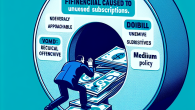
How I Finally Stopped Living Paycheque to Paycheque
How to Create a Budget That Actually Works
Let’s face it. “Budgeting” sounds about as much fun as watching a documentary about paint drying — in black and white. But here’s the truth: creating a budget isn’t about ruining your fun or becoming a human calculator. It’s about freedom, clarity, and yes, maybe finally saying goodbye to those awkward moments when your card declines at the coffee shop (we’ve all been there).
Hi there — I’m Tom Bradley, your middle-aged finance buddy who’s made every money mistake in the book (twice) and lived to tell the tale. If you’re just dipping your toes into the world of personal finance, I’m here to make sure budgeting doesn’t feel like punishment. So, get comfy, grab your beverage of choice (mine’s coffee, two sugars), and let’s build a budget that actually sticks.
Why Do You Even Need a Budget?
See, a budget is less “financial prison” and more “financial GPS.” It tells your money where to go instead of wondering where it went. With a budget:
- You stop living paycheck-to-paycheck.
- You can actually save for that trip to Spain or, you know, an emergency fund.
- You get less stressed about money. (That one’s underrated.)
In short? Budgeting gives you control over your money instead of letting your money control you. And the best part: making a budget doesn’t require a degree in Excel wizardry.
Step 1: Know Thy Numbers
Start With Your Income
Before you start putting money into buckets, you’ve got to know how much water is in the well. That means identifying your after-tax income — your “take-home” pay. If you have multiple income streams (full-time job, side hustle, grandma’s occasional birthday money), include them all.
What to include:
- Salary (after taxes)
- Freelance or gig income
- Alimony, child support (if consistent)
- Government benefits
Track Your Spending
This part may sting a little, but it’s crucial. Look back at your last 1-2 months of expenses. Yes, open up that banking app. Take notes. You’ll probably discover you spent more on delivery sushi than on groceries. No judgment — been there, done that, tipped generously.
Your spending categories will likely include:
- Housing (rent, mortgage)
- Utilities
- Food (groceries & dining out)
- Transportation (gas, rideshare, car payments)
- Debt payments
- Fun stuff (Netflix, concerts, spontaneous Amazon shopping)
Step 2: Pick a Budgeting Method
There’s no one-size-fits-all when it comes to budgeting. Choose a system that fits your lifestyle and personality. Here are a few widely used (and beginner-friendly) ways to budget:
The 50/30/20 Rule
This one’s a winner for simplicity. Here’s how it breaks down:
- 50% of income goes to needs (housing, groceries, bills)
- 30% goes to wants (movie tickets, hobbies, that midnight pizza)
- 20% goes to savings and debt repayment
Easy to track and surprisingly realistic. If you’re just starting out, this could be your go-to model.
Zero-Based Budgeting
This method assigns every dollar a job until you’re left with zero at the end. It doesn’t mean you spend everything; it just means every dollar is doing something — even if it’s sitting in your savings.
Perfect for folks who like being hyper-organized (or control freaks, no shame). Apps like YNAB (You Need A Budget) use this approach.
The Envelope System (Yes, Even Digitally)
Old-school but effective. You divide spending by category (groceries, gas, fun) and only spend from that “envelope.” If grocery money runs out — cereal for dinner.
Don’t want to carry real envelopes? Use digital bank accounts or budgeting apps that let you create folders or labels for each category.
Step 3: Fixed vs. Flexible Expenses
Now it’s time to break your spending into two categories:
Fixed Expenses
- Rent or mortgage
- Utilities
- Cell phone
- Subscriptions (like Disney+, because someone needs to finish The Mandalorian)
Variable Expenses
- Dining out
- Grocery bills (yes, these vary wildly — $40 weeks and $140 weeks)
- Fuel or transit
- Entertainment
This is where you can get creative. Fixed expenses are non-negotiable, but variable ones? Those can (and should) be adjusted as needed.
Step 4: Automate and Track
Set Up Auto Transfers
Use your bank’s tools to automate savings and bill payments. Treat your savings like a bill — just another monthly expense that gets paid. This is how you build wealth without thinking about it.
Want a quick-win tip? Open a savings account at a different bank so you’re not tempted to touch it. Out of sight, out of splurge.
Use a Tracking Tool
Sure, you could use spreadsheets. But why not let apps do the heavy lifting?
Popular tools:
- Mint
- YNAB (You Need a Budget)
- EveryDollar
- GoodBudget
Track weekly — not just monthly. Staying on top of your budget keeps little leaks from sinking your ship.
Step 5: Revise, Rinse, Repeat
Budgets aren’t statues — they’re more like puzzles that change every couple of months. Expect it. Adjust it. Don’t give up because it “didn’t work” after three weeks. That’s like quitting the gym because you didn’t get a six-pack after your first Zumba class.
When your income changes, when your expenses shift, or when life hits you with a surprise (it will), tweak your budget to reflect your new reality. It’s not failing — it’s adapting.
Wrapping It All Up
A good budget is like a good pair of jeans — it should fit you, be comfortable, and make you look (and feel) like a responsible adult. Start small, be consistent, and above all, give yourself grace if you mess up now and then.
At the end of the day, learning to manage your money is one of the most freeing things you’ll ever do. Your future self — with a healthy savings account and no overdraft fees — will thank you.
Need more help? Reach out to us through our contact page or learn who we are on our about section.








Leave a Reply